|
Any archery fan can add more enjoyment to the sport by
home-crafting primitive equipment. I'm an ardent primitive hunter. That is, I pursue game as the American Indians
did: I pick up an animal's trail, identifying species, size, and (sometimes) sex
… stalk the prey to within pulse-quickening distance … and bring it down with a
well placed arrow.
Now bow-hunting is a challenge in itself, but the
experience can be further enhanced by making your bow and arrows, using -- as
far as possible -- the same materials, tools, and techniques that have been
employed by bowyers for millennia. Of course, any number of excellent bows are
available on the market today, but it's my opinion that no factory-made item can
match the look and feel of a handcrafted bow.
I've fashioned many different types of bows, each designed to fit a special
hunting need: short, highly reflexed, sinew-backed weapons like those developed
by the American Plains Indians … long, recurved wooden bows in the style of
those used by Eastern Woodlands Indians … English longbows … and models that
borrow features from several other types.
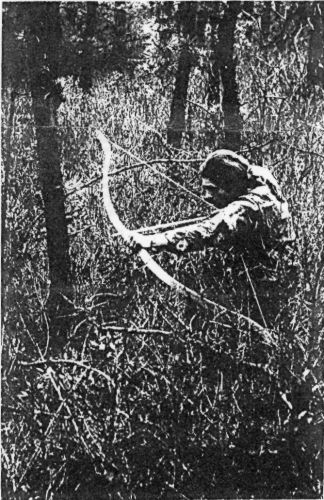
As a professional tracker, stalker, and close-range hunter (I teach these
skills for a living),
I prefer a bow that's recurved like an Eastern Woodlands model but shorter, with
sinew backing -- for strength and longevity -- and a twisted-sinew bowstring.
Shorter bows are easier to handle when I'm stalking through heavy brush and
making close shots with a minimum of elbowroom. For rainy day hunting, however,
I’m frequently forced to use a longer recurved bow that’s fitted with a
plant-fiber bowstring, which resists moisture-induced stretching. For bow
fishing, on the other hand, I prefer a longish self – or straight – bow.
Of course, most folks can’t afford the luxury of owning three different bows
… unless they make the weapons. So I’m going to tell you how to construct your
own archery tackle, using (for the most part) the techniques of the American
Indians … with frequent hints on how to speed up the process when you’re in a
hurry. Keep in mind that we’re not going to be covering the making and use of
survival bows, which are a different breed. Those weapons can be cobbled
together quickly and easily from whatever materials may come to hand, and
they’re suited only to very close-range shooting. Rather, this discussion will
concern the crafting of precision weapons: high-quality bows that will reward
your patience and effort with years of reliable accuracy.
Some of the techniques may sound a bit difficult, but don’t let the fear of
making an error keep you from trying your hand at them. The raw materials needed
are inexpensive or free, and experience is a great teacher … so read on, jump
right in, and make a few beginner’s mistakes, if need be. Keep at it, and you’ll
become proficient in the bowyer’s ancient art. I’m certain you’ll be glad you
did.
THE BOWYER'S BARE ESSENTIALS
To craft bows of high quality, all you need is a small workspace, a few common
hand tools, four inexpensive C-clamps, and a woodstove or other source of heat.
Nature will provide the rest of your tools and – if you keep your weapon
strictly primitive – all of your materials.
In some parts of the country, the traditional woods for bowmaking are
hickory, honey locust, mountain mahogany, and juniper. The best bow woods are
Osage orange (bois d’arc), yew, and ash. For the long recurved bow and the
longbow, I prefer white ash, which makes a good beginner’s wood for any style of
bow because of its “forgiving” qualities. Generally, though, Native Americans
used whatever materials were readily available, and you can do the same. If none
of the wood varieties I’ve mentioned grow in your area, you can even order a
straight-grained plank of appropriate size through a specialty hardwood dealer
(but be certain that the wood hasn’t been kiln dried).
If you want to harvest your own wood, look for a small tree that’s about 2”
to 3” in diameter, free of knots and blemishes, and straight. About 5½
feet should be a good length for any design except the longbow, which will need
about a foot more. You can also use a smaller sapling for a bow stave: Search
out one that's a little more than an inch through through the center and meets
the aforementioned requirements. The best time to cut wood is in February, when
the sap is down. Remember that the wood is a gift from the Creator and should be
taken with respect.
I season my staves by storing them in the shed until spring, then bring them
indoors until the wood has aged for a full year. The wood needs to be kept in a
cool, dry place during the seasoning process to prevent warping. If the thought
of having to wait a year before starting to work on a bow stretches your
patience, just buy an air-dried stave from your hardwood dealer and get right
down to business.
Once the wood has seasoned, it's time to remove the bark. Instead of carving
away the skin, scrape it off by holding a sharp knife at a 90 degree angle to
the wood ... so the blade won't slip and nick the stave. If you use a sapling,
carefully split the skinned pole down its full length. If you're cautious, you
can sometimes split two usable bow staves from a single sapling, but I don't
trust my splitting all that much and would rather carve with a drawknife until
the desired thickness is reached. Bows made from sapling will have a
semi-circular cross-section.
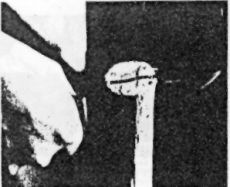 |
If you're
careful, you can split two usable bow staves
from a single sapling of about 1" diameter.
In the right hands, a larger sapling or limb
can be split into four staves. All
subsequent shaping must be done with
abraders; whittling can weaken the wood and
may cause nicks. |
|
| |
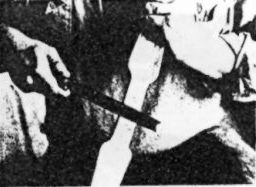 |
Use a rasp to
work the handle down to a size and shape
that feel comfortable in your hand. Thin and
taper the limbs gradually toward the bow
tips. There is no one best size or shape for
a traditional American Indian bow, but
strength and aesthetics should be taken into
account. |
|
|
If you use a larger tree for a stave, split it carefully in half, then --
perhaps -- in half again. (Some of the instructors at my wilderness skills
school can get four usable staves from a 3" diameter tree!) Bows made from a
small tree will usually have a slightly curved, rectangular cross section.
After you've made your initial splits or have shaped the stave with a
drawknife, all subsequent scraping will have to be done with scrapers, abraders
(rasps or files), and sanders ... since too much whittling will "thin out" and
weaken the wood's grain.
|
The Language of
Archery |
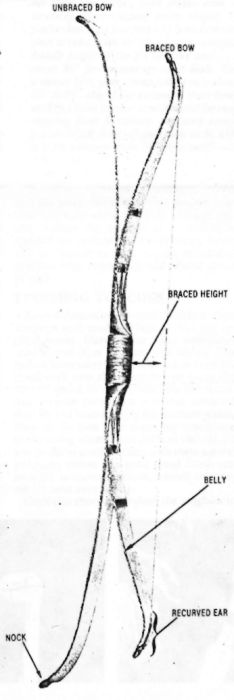 |
Like many specialized fields of human interest,
archery and bowmaking have their own jargon ... but by
reviewing the terms below you'll soon be able to "talk
archery" with the best of them!
- Back: The side of a bow that faces
forward, or away from the archer.
- Belly: The inside of a bow ... the side
facing the archer.
- Brace: To string a bow.
- Braced Height: The distance between the
string and handle of a braced, or strung, bow.
- Bowyer: The little old bowmaker.
- Draw: The distance, measured in inches,
that an archer pulls the bowstring.
- Ears: The forward-curving tips of a
recurved bow.
- Fletching: Feathers that have been split
in half and attached to the back portion of an arrow
to give it stability in flight.
- Limbs: The body of the bow exclusive of
the handle.
- Longbow: A straight wooden bow
approximately 6 feet long, with no reflex of recurve,
popularized in England during the Middle Ages..
- Nock: The notch in the back of an arrow
that receives the bowstring. Also, the notches on a
bow's tips that hold the bowstring in place. As a
verb, nock means placing an arrow on the
string.
- Recurved bow (or "recurve"): A bow having
the ends of its limbs bent forward.
- Reflex: A bend at the midpoint, or
handle, of a bow that causes the limbs to bow
slightly forward when unstrung.
- Self bow: A plain wooden bow, with no
reflex, recurve, or sinew backing. A longbow is a
self bow.
- Shaft: The body of an arrow, minus
fletching and point.
- Stave: A piece of wood from which a bow
is made.
- Weight: The strength, measured in pounds,
required to pull a bow to full draw. (Full draw is
generally considered to be 28".)
|
|
BENDING TO THE BOWMAKING TASK
With the stave aged, peeled, split, and rough shaped, you're ready to get on
with the real work of making a bow. At this point, it's a good idea to "ask" the
wood what type of bow it wants to become rather than trying to make it what you
think it should be. In other words, take into account the wood's quality, grain,
and growth patterns in deciding how to shape the tool that it will become.
Generally speaking, wide and thin is the best shape for softwood bows. The
extra width is necessary to help prevent cracking. Softwoods tend to splinter
more readily than do the less brittle hardwoods, so hardwood bows can be made a
little thicker and quite so wide.
When I produce my bows, I never rely on tape measures or calipers. I've
learned to rely on what feels good for me and for the wood. Thus, the dimensions
given in this article are by no means law ... they're only averages to help you
in making your first bow. After you've shaped one or two, you'll be able to use
touch, sight, and your own inner feelings to make a bow that's as personal as
your fingerprints.
This initial steps in making a bow are the same, no matter what design you've
chosen for the finished product. First, cut the stave to the length you want
your bow to be when completed (here, I'll be discussing one that's 5 feet long).
Now, find the longitudinal center point and measure out about 3" in both
directions (this 6" area will become the grip, or handle). The next job is to
taper and thin the limbs. Starting from the outside of the grip area, and using
a rasp or coarse-toothed file, begin thinning and tapering ... from a thickness
of about 5/8" at the handle, down to 3/8" at the tips (you want to achieve a
smooth, even taper). The width should slope from 2½" or so
near the handle to about ½" at the tips. As you work on this phase of the
project, be sure to keep the back and sides of the bow as flat (as opposed to
rounded-off) as possible ... and also take care not to overdo the thinning.
Now, work on sculpting the handle to a size and shape
that pleases your grip. Thin the handle area in width and thickness until it
fits your hand comfortably, and the put the finishing touches on the overall
shaping of your bow with a finer file, such as a mill file. And, while you have
that mill file in hand, go ahead and cut string notches in the end of each limb
... deep enough to hold the bowstring in place but not deep enough to weaken the
bow limb tips.
With that done, it's time to test the bow to see if the
limbs pull evenly. Tie a strong cord from tip to tip -- as if it were a
bowstring -- then place your bare foot on the handle and pull upwards on the
center of the cord until the limbs begin to bend. Be careful not to pull the
ends up very far at this stage, since excessive flexing might cause splitting if
the limbs aren't even. If you find that one limb pulls easier than the other,
carefully abrade away the belly of the stronger side, using a mill file, until
the limbs pull evenly. (The evening process is known to bowyers as "tillering".)
While performing this test, you'll also get some idea of the draw weight your
bow will have when finished. Though you can increase the stiffness of a
too-flexible weapon by applying sinew backing, being able to predict its draw
weight in advance requires long experience and liberal doses of luck.
FINISHING TOUCHES
Native American bowyers finished their weapons with
rendered bear or deer fat, applied warm. Deer brains were sometimes used instead
of, or together with, the fat. The Indian bowmaker would then set or hang his
handiwork near the lodge fire to warm the fat and speed its absorption into the
wood. My personal preference is to mix rendered deer fat and brains, apply the
mixture warm, then set the bow high above my woodstove so the rising warmth can
drive in the oils. (If you prefer to avoid working with these natural products,
almost any good wood finish can be used, including varnish, linseed or cedar oil
... and even lard.)
Once this chore is finished, the longbow is ready to
shoot. Go easy at first, giving your new hunting tool a chance to break in.
Sometimes, though, no matter what you do in an effort to prevent it, a new bow
will snap. This is probably due to a flaw in the wood rather than something you
did wrong, but in either case there's nothing to do except try again, using your
newly gained experience to ease and improve the next effort.
We'll discuss the details of sinew backing a little
later on, but it should be briefly mentioned at this point that sinew will keep
a new bow from breaking, improve its snap and cast, and add pulling pounds to
the limbs. I therefore suggest that all your bows be sinew-backed, even though
the technique was not traditionally used on longbows.
PUTTING THE CURVE IN A RECURVED BOW
To enhance your hunting weapon's speed, power, and beauty, you may want to
add recurve to the limbs. For a recurved bow, follow the instructions for the
self bow and longbow but stop short of applying the brains and fat. What you're
going to do now is to bend the last 6" or so of the limbs forward. Set a
large pot of water (a big coffeepot is perfect) on the stove to boil. When it's
bubbling, dip one end of the bow into the water, up to about 9", and let it
"cook" for 3½-4 hours. While the bow end is in its hot
bath, cut a recurve form -- as shown in an accompanying photo -- from a piece of
scrap 2x4 lumber (you'll need one for each limb). The exact curve of the form is
up to you, as long as it is not beyond the bending capabilities of your stave.
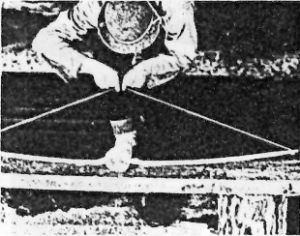 |
With the basic
shaping of the bow completed, it's time to
check the evenness of limb-pull. Tie a stout
cord from end to end of the bow, place your
bare feet on the handle, and pull up gently.
If one limb is stronger than the other,
carefully abrade away belly wood until the
limbs pull evenly. |
|
| |
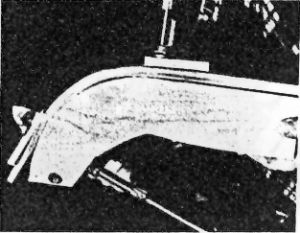 |
To put the
curve in a recurved bow ... boil the bow tip
for 4 hours, then place it over the convex
side of a 2x4 form. Lock the tip in place
witha C-clamp, then bend the limb
around the form and lock it down with a
second clamp. Allow at least 24 hours before
removing the clamps. |
|
|
When the first bow-end has finished boiling, place it over
the convex side of the form and secure it with two C-clamps. The best approach
here is to fasten the tip of the limb in place first, then -- using the bow as a
lever -- slowly bend the limb back over the form and clamp it down securely. (To
keep the limbs from getting dented, use small blocks of soft wood between the
clamps and the bow.) At this point -- with the first end of the bow locked over
the bending form -- start cooking the other tip ... then repeat the clamping
process. Now, give the bow a full day of rest in a warm, dry place.
The next step is to remove the clamps and fine-tune your
newly recurved bow. Tuning is accomplished by removing a little of the belly
wood at the point just before the recurve begins. I usually take off 1/16" to
1/8" of belly wood, starting at the base of the recurve and working back about
6" toward the handle. I find that after I've done this fine-tuning, the bow has
a faster action and reduced kick, or jolt. (Some bowyers say that this final
shaving keeps the recurve's "ears" from snapping off, too.) Once your bow is
tuned, you can either sinew-back it or finish it up as you would a longbow.
And if you want to give your hunting tool even more zip and
zing, you can add a reflex to the bow by bending the back slightly forward. Just
heat the handle area over a steaming kettle of water for a couple of hours, then
lay the bow -- its back facing down -- over a small log, and stand barefooted on
the limbs until the wood has cooled (it doesn't take all that long). This will
produce a forward curve or reflex, adding even more punch to the weapon. (Reflexing
is especially important for extremely short bows similar to the stubby "horse
bows" that the Plains Indians used so effectively against the tough-hided
buffalo.)
|
Arrowmaking:
Straight and Fast |
| |
|
 |
| |
| To complete your primitive-archery out-fit, you'll
want a supply of arrows to go with your custom-made bow
... projectiles that are every bit as functional and
beautiful as their launcher. Cherry, serviceberry (Juneberry),
ash dogwood, cedar, bush blueberry, and even cane and
reed are good woods to use for arrow shafts. Cut
sections about 3 feet long from saplings with base
diameters of ½" or so, and
take the time to search out knot-free shafts. Collect
your arrow wood during the winter, when the sap is down.
After bundling the shafts together into tight packages
tied every few inches with cord, let them season as you
did your bow stave. When the shafts have aged for a
full year, remove the bark, again by scraping
instead of carving (because they are so much thinner
than bow staves, even greater care is necessary when
shaping arrow shafts). If you're shooting a 5-foot-long
bow, measure your arrows from the tip of your extended
middle finger to the pit of your arm ... about 30" for
the average adult male. For a shorter bow, your arrows
will be only about 23" - 25" long. (The extremely short
bows used by Plains Indians were designed for easy
shooting from horseback and were rarely pulled to full
draw. If you want to be able to shoot a long arrow at
full draw, you'll need a bow that's at least 48"
long, preferably longer. Otherwise -- even if the bow is
well-made and doesn't break -- your fingers will suffer
string pinch due to the acute angle formed when a short
bow is overdrawn.)
Using coarse-grained sandpaper, smooth the arrow
shafts down to a diameter of about 5/16". Then switch to
a fine-grit paper or emery cloth for finishing. Once the
shafts are smooth, rub them with rendered fat and warm
them near the fire to induce absorption of the oils. (Of
course, you could also simply buy 5/16" hardwood
dowels.)
Crooked arrows can be straightened by heating them,
bending the kinks out with your fingers or your teeth,
and holding the shafts straight until they cool.
Sometimes it's necessary to use an arrow straightener,
or wrench, to unbend stubborn spots on an arrow. To make
this tool, drill a shaft-sized hole through a piece of
antler or bone. Then stick a heated shaft through the
hole and use the wrench as a lever to bend out the
kinks. |
|
 |
| Next comes the fletching. I find that a 6" long
fletching, trimmed to a height of about
½", provides good aerodynamics and
closely resembles the traditional Indian style. Turkey
tails feathers are the best, but the tail plumage of
almost any large of medium sized bird will do in a
pinch. (Just be sure not to use feathers from any of the
many protected species of birds or you'll be
letting yourself in for a federal-type felony!)
You'll need three fletches for each arrow. Start by
cutting longitudinally along the median line of each
feather's quill, splitting the feather into two equal
halves. After carving away the pith and excess quill,
trim the feathers to the proper height, and check to see
that they're all of a uniform size and shape.
To fasten the fletches to the arrow's shaft, hold the
backs of the feathers in place at the nock end of the
shaft, and bind the fronts of the feathers to the arrow
with a wrapping of moist sinew. (Some bowyers
temporarily anchor the fletches to the shaft with pine
pitch or diluted hide glue, thereby feeing both hands
for the wrapping chores.) Apply the sinew by first
separating it into threads, just as you did for the bow
backing, then wetting it with saliva and wrapping it on
evenly. The saliva-and-sinew mixture forms its own glue
and doesn't have to be tied. After the front wrappings
have dried, repeat the process at the back of the
fletchings, wrapping up to the base of the nock. The
dried sinew is almost transparent, lies close to the
shaft, and tightens up even more as it ages.
To cut the bowstring notches in the backs of the
arrows, abrade a U-shaped slot with a small rat-tail
file (or saw carefully with a hacksaw) down to just
above the top sinew wrap behind the fletching. The nock
will then be supported by thee sinew wrap, preventing
the shock from the bowstring from splitting the shaft.
Be sure to position your string notches so that when the
arrow is shot, two feathers will pass across the bow
evenly, with the third-or "cock "-fletching protruding
at a 90º angle away from the
bow.
The size of the arrowheads and the notches that will
hold the heads onto the fronts of the shafts will be
determined by the animals you plan to hunt, your
personal preference, and your state's laws. In my state,
as in most, it's illegal to hunt big game with anything
other than a wide steel broadhead. Steel heads can be
cut from any source of thin sheet steel, using a jigsaw
or tin snips, then filed and honed razor-sharp. (The
Plains Indians actually got much of their arrowhead
metal from the iron rims of wagon wheels.) Take care to
make the proper base shape -- or notch -- on the backs
of the heads so they'll fit snugly into the arrow-shaft
notches and provide a good anchor for sinew wrapping.
Bone arrowheads can be almost as sharp and deadly as
steel broadheads. Just use the cannon bone from the
lower of a deer; split the bone in half, file to shape,
and sharpen.
Then too, stone points can be chipped from flint,
chert, jasper, quartz, obsidian, and even glass.
Flint-knapping is a complex topic and would require an
article of its own for even a cursory treatment, but
tests have shown that well-made stone heads can achieve
even greater penetration than steel.
OK ... you've formed your arrowheads -- steel, stone,
or bone -- and cut the slots they'll fit into on the
arrow shafts. Now it's lime to bind the points to the
shafts: Just slip the heads down into their notches and
apply a good wrapping of spittle-moistened sinew, as you
did with the fletchings.
Once the heads have dried in place, your arrows are
ready to shoot.
For hunting, it's best to leave the shafts more or
less natural or to crest them with subdued colors. But
for target practice, you might apply decorative stripes
to your arrows ... an artistic touch that will also help
you follow those erratic shots that will inevitably send
an arrow slithering beneath a cover of grass and leaves. |
| |
|
 |
|
SINEW-BACKING BASICS
The two ingredients necessary to sinew-back a bow are sinew
from the leg and back tendons of animals, and hide glue (made from. hide
shavings and hooves). I prefer to use the leg
sinew of deer and elk ... though horse, buffalo, cow, goat, and moose sinew work
just as well. If you're not a hunter -- and don't know one -- arrange to buy
tendons from the local slaughterhouse. Usually, the people there will just give
them to you (and probably decide that you're a bit strange).
After cutting the tendons from the legs and back of an
animal, prepare the sinew by removing the clear sheath that holds the tendons
together. Then place the exposed bundles well above a heat source to dry. When
they're no longer moist, pound the tendons on a board, using a wooden mallet or
a smooth rock as a hammer to separate the bundles of tissue into individual
threads. To prepare hide glue, put hooves, hide
scrapings, and dewclaws into a pot with just enough water to cover them, and
boil the "stew" for several hours. (To get a finer consistency, you may want to
skim off the scum that bubbles up to the top of the boiling pot.) You'll end up
with a thick, glompy mass of glue that's perfect for the job of welding sinew
strips to wood. (An alternative to homebrewing is commercial hide glue,
available at many hobby shops in both liquid and powder form. But the
store-bought stuff lacks the authenticity -- and rousing aroma -- of the
homemade material. You can forget about epoxy and other chemical binders: They
definitely won't work.) When you get ready to use
the glue, keep the container warmed in a water bath atop the stove (120°F or
thereabouts is perfect), since at room temperature the adhesive gets gummy and
sets up too fast, especially if your workroom is cool to begin with.
Prepare your bow to receive the glue and sinew by roughing
up the back with a hard, abrasive rock. Make sure the wood is cleaned of any
greasy fingermarks or dirt, then paint the bow's back with hide glue that's been
thinned in a ratio of about two parts glue to one part warm (preferably
distilled) water. Next, wet the sinew strips and place them -- a few strands at
a time -- into the hide glue to soak for a few minutes.
Squeegee off excess glue as you remove each piece of sinew
from the glue pot, and -- starting at the longitudinal center of the bow and
working out toward the tips (or the other way around, if you prefer) -- apply
strips of glue-soaked sinew, laying them parallel to the limbs and as straight
as possible. Cover the entire back of the bow with the sinew, and try to make a
smooth job of it, staggering the ends of the strands to avoid making seams.
Apply sinew all the way to the tips of the limbs, then fold about 2" over to the
belly side to strengthen the tips. Once the back is sinew-covered, let it dry
awhile, then apply two or three more coats of sinew and glue. When you're
finished, let the bow rest for at least a couple of weeks.
After the sinew has cured, shoot your weapon a few times at
half draw to see if it needs any more fine-tuning. If you find that you need to
even up the pull of the limbs again, simply tiller the sinew just as you did
with the belly wood earlier. (Sinew works well under a mill file.) Finally,
finish your bow with a mush of rendered fat and deer brains, as described for
the longbow. This time, however, don't place the bow near heat.
As time goes by, you'll find that the sinew continues to
pull against the bow's belly, producing a forward curving, or reflex ... but
don't be alarmed, since more reflex will only strengthen the weapon. After a
year or two, the sinew will have pulled all it's going to, and your bow will
have assumed its permanent shape and shooting characteristics ... and will last
a lot of years if properly cared for.
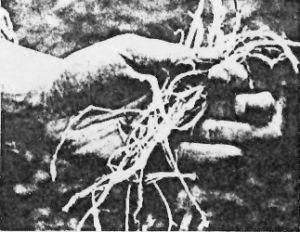 |
The two
ingredients necessary to sinew-back a bow
are sinew fibers from the leg or back
tendons of animals, and hide glue (which can
be prepared from raw materials or
purchased). After the tendon bundles are
dried and pounded, they will separate into
individual strands. |
|
| |
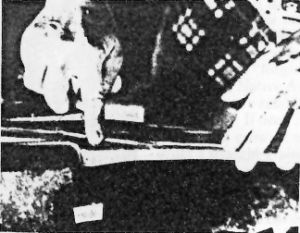 |
To apply
sinew, first rough up the back of the bow to
provide a good gripping surface for the
glue. Wet the sinew strands, soak them in
hide glue, then apply them in parallel rows
until the entire back of the bow is covered.
Allow the glue to dry, and then apply two
more layers. |
|
|
STRING THAT
BOW Reverse-wrapped sinew is the traditional
fair-weather bowstring. And for wet-weather shooting, the fibers of plants such
as velvetleaf, hemp, dogbane, and nettle work admirably. By reverse-wrapping a
string to more than twice the length of the bow, then folding the cordage in
half and reverse-wrapping it again, you'll produce a strong and durable
bowstring with a loop at one end. The other tip end can simply be tied to the
bottom limb. (For a photo-illustrated guide to reverse-wrapping, see my article
"Making Natural Cordage" in MOTHER NO.79, page
38.) And, of course, those of you who are in a hurry can just trot down to the
local sporting goods dealer and purchase a ready-made bowstring of the
appropriate length. To determine the correct
bracing height for your bow (and -- in turn -- the correct length for your
string), place one fist on the inside of the grip and extend your thumb as if
you were trying to flag a ride ... the attached string should just touch the tip
of your outstretched digit. PARTING SHOTS
Before Europeans entered the picture with their advanced
technology and metal tools, Native American bowyers painstakingly fashioned
finely crafted bows with stone and bone implements. The process took a lot
longer, but Stone Age humans weren't as frantic about the passage of an hour as
today's ulcer-ridden people tend to be. And those earlier products were often
every bit as beautiful and serviceable as fine machine-laminated bows.
Archery has had a long history not only in the Americas but
in virtually every corner of the globe except Australia. The ancient Turkish
horn-and-sinew composite bows -- to cite one shining example -- were quite
probably the most effective primitive weapons the world has ever known. Bows are
silent, pinpoint-accurate in practiced hands, designed to test the hunter to the
extremes of his or her skill ... and they offer the game animal a sporting
chance. [EDITOR'S NOTE: As you know, there's a
great responsibility placed upon the hunter who uses primitive weapons ... to
develop his or her accuracy to the maximum and to avoid taking any shots that
might result in losing a wounded animal.] In
addition to saving the hundreds of dollars that it would cost to equip yourself
with a top-quality modern compound bow and fiberglass or aluminum arrows,
hunting with a piece of wood that's taken on a beautiful shape under your own
hands can help you achieve harmony with nature and the past, a harmony which has
all but disappeared from our over-mechanized, depersonalized world.
AUTHOR'S NOTE: Native American Archery by Reginald
and Gladys Laubin is the ultimate authority on this subject and can be ordered
from The University of Oklahoma Press. Clothbound and in large format, the book
goes for $18.95 plus shipping and handling. It's a steep price, but for the
serious archer, bowyer, or historian the book is worth every penny.
For more material by and about Tom Brown Jr. and the Tracker School
visit the Tracker Trail
website.
|